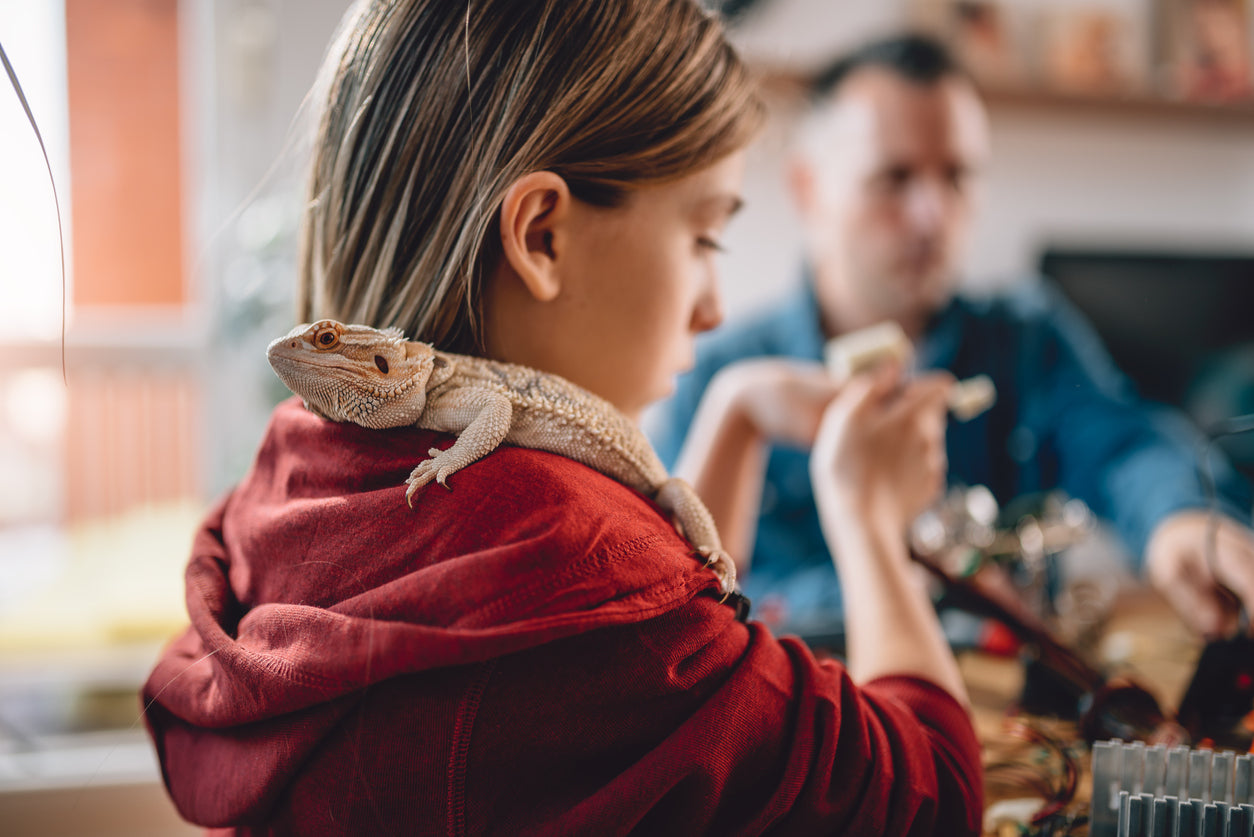Bearded dragons are oviparous, which means they lay eggs rather than letting their young gestate within their bodies like mammals.
Female bearded dragons lay eggs whether they are fertile or infertile. Fertile eggs occur when the female has mated with a male, whereas infertile eggs are when the dragon hasn’t been with a male, but she has still prepared eggs to be laid. The development period from ovulating (creating the eggs) to laying can last around 3 to 4 months regardless of whether the eggs have been fertilized or not but there are certain factors that can affect how long this process can take, as well as certain issues that can arise during this process.
“Gravid” is the term used to describe a female who is in the process of preparing eggs to be laid and carrying these eggs within her. There are a few ways to tell if your female may be gravid. They tend to scratch and dig a lot whether it be at their substrate or at the sides of their enclosure. They will seem to become very active, almost frantic, and dig at whatever they can find. They can also have some appetite changes and either start to eat more or even less than usual. Their poop may also change a bit. You may notice that they are pooping more often, sometimes 3 or 4 times per day and that these stools may be quite small and seem to consist of only soft urates. There may also appear to be tiny traces of blood in their stools. It is possible that you can also notice that your dragon may appear quite bloated, even if it’s not eating as much. Towards the end of this process you may even be able to feel the eggs within her belly. They can feel like grains of rice but you must be careful if you are looking for this as the eggs are fragile and breaking them within your dragon can have some very bad consequences for your dragon’s health. If your dragon has any or all of these symptoms then the next step would be confirmation which would involve gettingyour dragon checked out at the vet. The vet will likely want to do an X-Ray or an ultrasound to confirm the presence of eggs.
If your dragon is indeed gravid then you will need to do a few things to get ready. The first thing to do is to prepare a lay box for her. A lay box is used to provide a safe comfortable space for your dragon to lay its eggs. Its need this because if it doesn’t feel comfortable, it may keep the eggs inside. This is called becoming “egg bound” and can be extremely serious as the eggs start to go bad inside your dragon or break inside your dragon requiring emergency veterinary attention. A lay box consists of a large box, (a plastic tote works well) filled 1/3 of the way with a substrate such as kids’ play sand, kept damp to the consistency that you would be able to make sand castles with it. A heat lamp is usually placed over this to keep your dragon warm. Place your dragon in this for a few hours per day until the egg laying process is complete. A dragon can lay a clutch of anywhere from 15 to 30 eggs or even more so if they only lay a few they are most likely not finished yet. When the process is completed you will need to supplement your dragon’s diet with extra calcium, protein, vitamins and hydration as the process can be draining on its body. Also, provide it with plenty of heat and UVB for some comfortable basking time so it can rest.
Even though every dragon has the ability to lay infertile eggs it doesn’t mean that it will. Some dragons may go their entire lives without laying infertile eggs whereas others will lay like clockwork. Others may lay once and never again and everything else in between. There are certain environmental factors that can come into play which can induce your dragon to lay: being around other dragons can make it want to prepare
an infertile clutch ready for a male to fertilize but again this isn’t certain.
If you have mated a pair of dragons or you have recently purchased a dragon and it appears to be gravid and you aren’t certain of its history it’s possible that the eggs could be fertile. Fertile eggs appear to have thin red veins running through them when held up to the light. If you choose to keep your dragon’s eggs, be aware that the process of raising baby dragons is a very expensive one and requires a lot of attention and time to get right. One reason there are so many dragons on the market that are sick and needing homes is over-breeding and incorrect breeding from being ill prepared for raising the baby dragons. If you choose to not incubate the eggs then you can simply toss the eggs. Freeze them first if they will be in the trash to prevent them from smelling.
If you decide to incubate the eggs, it’s recommended to buy a specially prepared incubator to use for the eggs; you can buy these online. You need to ensure that the soft bedding being used is kept moist and warm. Dragons eggs incubate at a temp of around 84°F. Anything above 90°F can destroy the developing embryos inside the egg. Eggs that have been kept between 82°F and 85°F can take from 2 to 3 months to hatch. Always ensure that you are well prepared for any babies that you hatch. You will need all the tanks and lights and everything set up, and all the babies will require vet visits to ensure they
are healthy.




Leave a comment
All comments are moderated before being published.
This site is protected by hCaptcha and the hCaptcha Privacy Policy and Terms of Service apply.